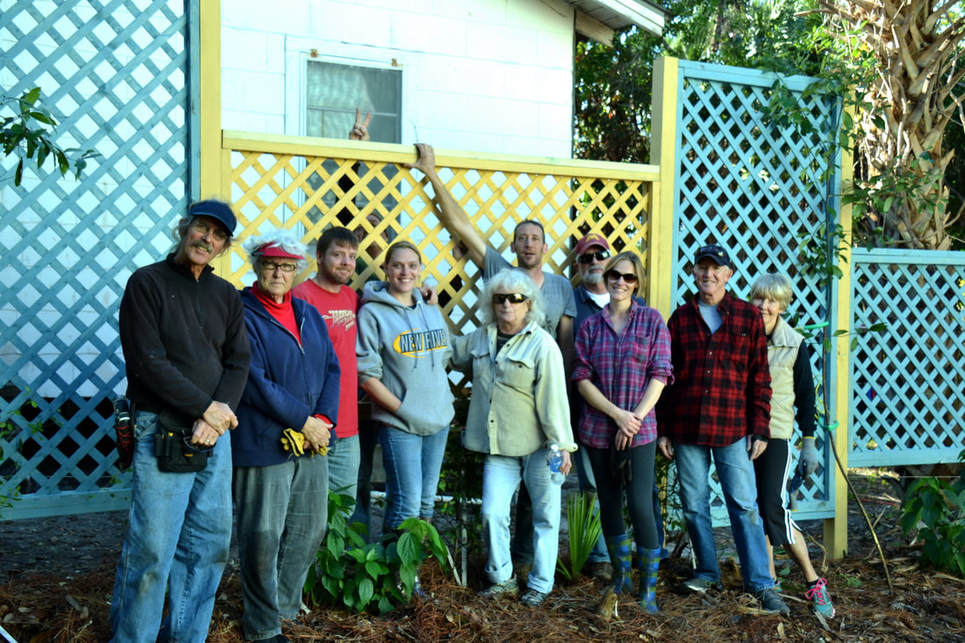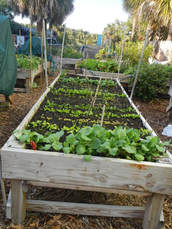INTEGRAL TO OUR MISSION AND OUR HISTORY
ORGANIC GARDENING
The Cedar Key Community Garden was established as an organic garden. That was not a rule but rather Garden members wanting to grow organically. Folks that had grown with chemicals in the past, were willing to give organic growing a try. The Cedar Key Community Garden clearly shows that you can grow a lush, productive garden with no chemical input.
The Cedar Key Community Garden was established as an organic garden. That was not a rule but rather Garden members wanting to grow organically. Folks that had grown with chemicals in the past, were willing to give organic growing a try. The Cedar Key Community Garden clearly shows that you can grow a lush, productive garden with no chemical input.
|
COMMUNAL BEDS
The Cedar Key Community Garden has two communal beds with the intent that seeds would be started in these beds. Once they reach transplant size, all the gardeners share the transplants. These beds are replanted up to six times a year to provide a continues supply of transplants for Garden members. By doing this Gardeners can save 3 to 4 weeks in their rotation thus producing more produce in a limited space and in a shorter amount of time. |
|
SEED GIVEAWAY PROGRAM
The Cedar Key Community Garden established a seed giveaway program in the fall of 2017. Gardeners collected seed through the summer and fall. Members put seeds into envelopes and put them in a waterproof container by the entrance to the Garden. Visitors can take up to three packets of seed. There is a donation box next to the seed; if someone wants to make a donation, it is convenient to do so. |
OUR HISTORY
The idea of the Cedar Key Community Garden was discussed in early November of 2015, during a conversation between Mandy Offerle and Tom Deverin, both Cedar Key residents. Tom stated that he always thought that Cedar Key would benefit from having a Community Garden. Delighted with the idea, Mandy's response was that she and her husband Frank had a piece of land that they would allow to be used for a Community Garden, on a long-term basis. The city-centered lot is 200 feet deep and 50 feet wide with access to public roads on the north and the south. We went and looked at the property and it was about perfect: the lot was already cleared, city water was already on site, and the lot sits in the middle of town with a shady area to sit and relax. So they decided to pursue the establishment of the Cedar Key Community Garden.
Both being members of the Cedar Key Garden Club, they went to the fully-attended annual meeting in mid-November. When the floor was opened to suggestions, Tom suggested that we establish a Community Garden and a vision of what that Garden would look like and how it would work. Membership wholeheartedly supported establishing a Community Garden. Mandy and Tom then met with the Board of the Garden Club to discuss establishing the Community Garden. It was agreed that the Community Garden group would work with the Garden Club to start the Community Garden and that after two years it would stand on it own… it took one year. A three-member Board, comprised of Mandy, Tom, and Joe Hand, a Garden Club Board member, was established to organize and build out the Community Garden.
Things moved pretty quickly after that. December 9, 2015, was the first of three work days. From 25 to 45 volunteers would show up for these events and work really hard on the tasks at hand. There were also smaller groups of folks who worked several days on smaller projects and doing prep work so that larger work events got a lot accomplished. The Community Garden opened on February 1, 2016, less than two months after the first work day.
During that time, donations raised from the island community community totaled more than $9,000; since then that number has climbed to almost $14,000. On the opening day, many transplants that were started on the first work day were made available to the gardeners. The results were that, at the end of that day, almost all of the beds were full of green, organically grown transplants ready to grow on.
It took quite a bit of work to establish the Garden, approximately 1,000 volunteer hours. Most of the beds are at tabletop height, 32", so they took some time to construct. The beds were then put in place and filled with two dump truck loads of compost; a trellis was installed along one fence line; landscaping was planted throughout the Garden; an irrigation system for the beds was installed along with a shell path; and everything was mulched. Since then there has been a steady stream of improvements to the Garden: drip irrigation, art work, more seating, more plants and trellises, and three additional beds. Currently there are 23 tabletop beds and five raised beds on the ground.
Things moved pretty quickly after that. December 9, 2015, was the first of three work days. From 25 to 45 volunteers would show up for these events and work really hard on the tasks at hand. There were also smaller groups of folks who worked several days on smaller projects and doing prep work so that larger work events got a lot accomplished. The Community Garden opened on February 1, 2016, less than two months after the first work day.
During that time, donations raised from the island community community totaled more than $9,000; since then that number has climbed to almost $14,000. On the opening day, many transplants that were started on the first work day were made available to the gardeners. The results were that, at the end of that day, almost all of the beds were full of green, organically grown transplants ready to grow on.
It took quite a bit of work to establish the Garden, approximately 1,000 volunteer hours. Most of the beds are at tabletop height, 32", so they took some time to construct. The beds were then put in place and filled with two dump truck loads of compost; a trellis was installed along one fence line; landscaping was planted throughout the Garden; an irrigation system for the beds was installed along with a shell path; and everything was mulched. Since then there has been a steady stream of improvements to the Garden: drip irrigation, art work, more seating, more plants and trellises, and three additional beds. Currently there are 23 tabletop beds and five raised beds on the ground.



